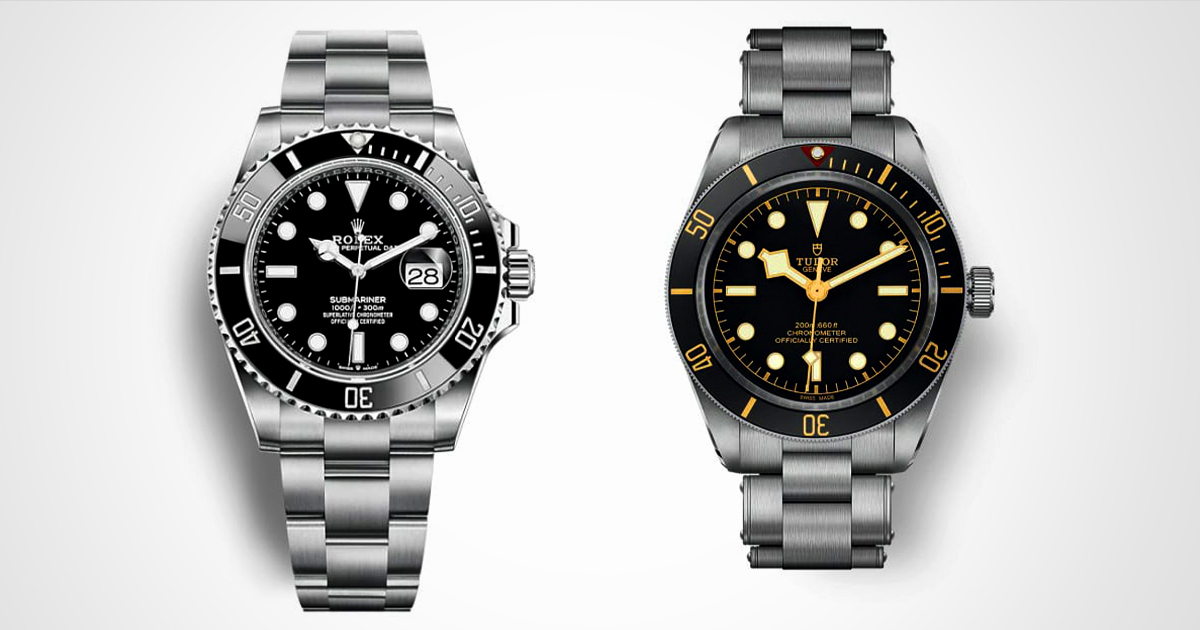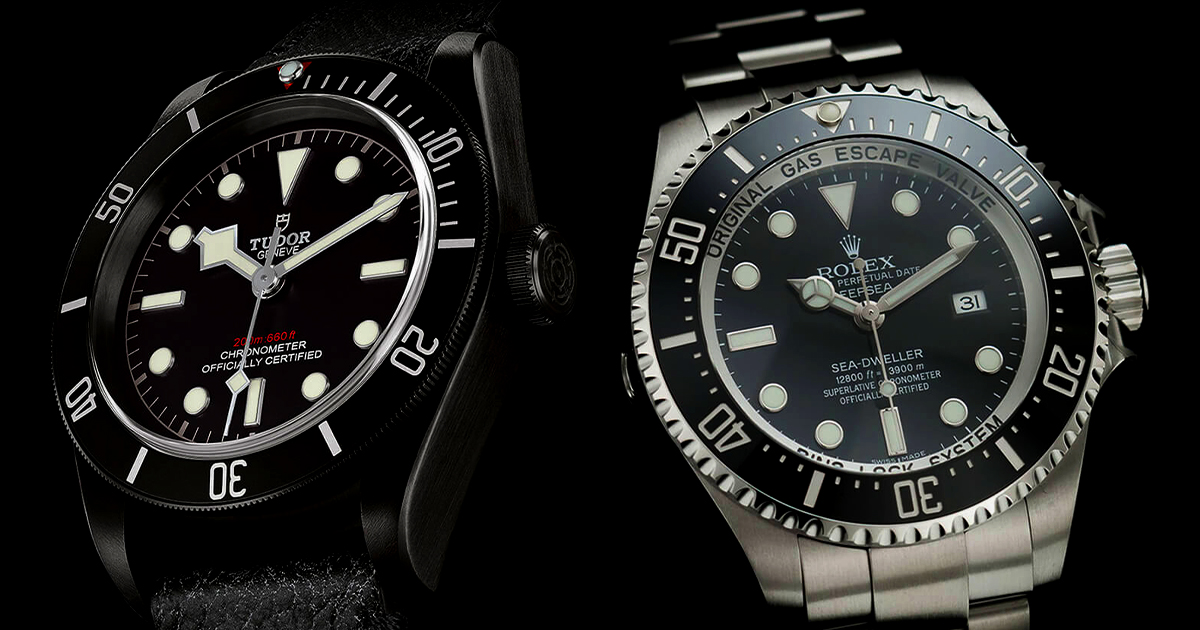Rolex vs Tudor – Complete comparison

First, we should say that Tudor and Rolex watches brands have a strong history that spans centuries. Notwithstanding this, few individuals are aware of the relationship’s history or what it entails. Most crucially, there is the inevitable question of which is better: Tudor or Rolex.
We decided to prepare an in-depth article about Tudor and Rolex relationship, but here’s a quick rundown:
Hans Wilsdorf, who invented Rolex, also created Tudor in 1926. From the past until now, we’ve been exploring the notion of developing a timepiece that our dealers might sell at a lower price than the Rolex watches.
Still, yet achieving the criteria of reliability for which Rolex is recognized, he declared when he founded Tudor. Tudor Watch Company, it’s named.
As a result, Tudor was created as a low-cost Rolex brand that aimed to achieve the same or equivalent qualities.
In this step, we want to have a quick look at both watches’ definitions:
Table of Contents
Rolex
Rolex is the most well-known watch brand globally because of its groundbreaking technological achievements in twentieth-century horology.
While many experts and athletes wore the firm’s watches, it gradually became a fashion icon rather than a specialist in tool timepieces. The distinctive understated-yet-extremely-fashionable designs of Rolex watches drew enthusiasts in.
Rolex is a cautious brand in many aspects. It’s discovered something which works, and it hasn’t strayed too far from its primary sense of fashion, which has stood the test of time. Its collections rarely feature central new ideas; when they do, it is done deliberately and gradually.
Different collectors like minor variances among many types. What Rolex offers is a sense of authentic, long-lasting elegance that everyone can appreciate. Nobody compares to it in terms of prestige and thoroughness.
However, its steadfast adherence to its tried-and-true formula has occasionally left watch people hoping more.
Tudor
Tudor is the primary watch character in the story. This is a brand that has never hit the press or gained widespread recognition.
It has attracted the attention of many watch enthusiasts and professionals since its creation in 1946. The Tudor Submariner of the 1950s was similar to the Rolex Submariner in that it used the same casings.
Tudor was sought by several sections of the military from various countries, notably the US armed forces, in the 1950s and 1960s for diving missions and scientific expeditions to places like Greenland.
For a long time, the brand disappeared from the US and international market, only to return victorious in 2013.
Tudor has added a little more “revolutionary” to Rolex’s plodding “evolution” in the intervening time. The corporation has been given more leeway to explore and experiment with new concepts, often resulting in outstanding achievement.
One effect of this liberty is icons like the iconic Tudor “snowflake” hands. On the other hand, Tudor has developed a history alongside Rolex, not only under its wing. This is the foundation of the magnificent Tudor Heritage series, which debuted in 2010.
Critics have acclaimed it for its spectacular usage of its previous designs to inspire a new range of beautiful watches, such as the Tudor Black Bay, which has caused quite a stir in the industry.
So, how do Tudor and Rolex vary and complement one other? Let’s have a look…

Differences and similarities between Tudor and Rolex watches
Maybe you heard this phrase about the Tudor brand that it is a “poor man’s Rolex” said by many. However, if you read our essay on the subject, you will see that this is just not the case.
However, because Tudor is a Rolex budget brand, it can be a watch with lower quality but at a lower price. With that stated, while the Tudor has poorer quality than Rolex for understandable reasons, it can nevertheless deliver the same bang for the buck because the timepieces are significantly less expensive.
In that way, comparing the performance of Tudor VS Rolex isn’t entirely fair because the two watches are supposed to rival, neither in terms of performance nor in terms of cost.
Let’s start comparing these two brands together:
· Design and style
We’ll begin by contrasting the styles and designs of these two watches. The truth is that Tudor and Rolex used to have a lot more in common than they do now.
Because Tudor wristwatches are made with Rolex materials but with different mechanisms, it can be said that old Tudor watches are pretty similar in design to Rolex watches.
This issue has changed in recent years, as Tudor has increasingly gone its way and tries to be different from Rolex.
Tudor has its unique designs now, but because many of its models are inspired by its past, you may still discern design features and characteristics from Rolex watches.
Although there are parallels between Tudor and Rolex watches, you will notice them mostly between Rolex’s old timepieces and Tudor’s current watches, as Tudor draws influence from its legacy.
While the parallels between modern Rolex and Tudor watches are noticeable, they are considerably more apparent when looking at Rolex’s historical watches.
On the other hand, Tudor is a test dummy for Rolex, testing the industry by attempting new things and experimenting with diverse styles.
On the other hand, Rolex is significantly more cautious and would never endanger its image or tradition by launching new bold and adventurous models.
“Born to dare” is Tudor’s slogan in part because of this.
The benefit of Rolex being allowed to use Tudor as a guinea pig is to test the waters. When something is well-received, Rolex may be able to incorporate it into future watches.
· Prices
Tudor and Rolex are priced so significantly is the main reason for the difficulty in comparing them. They’re working in two different professions.
Tudor is meant to appeal to a more entrance market, while Rolex is intended to appeal to a more wealthy market.
The most affordable Tudor watch is around 2000 dollars, while the most affordable Rolex watch is the woman’s Oyster Perpetual, which costs more than 5000 dollars.
Tudor timepieces, on the other hand, cost less than half as much as Rolex timepieces. For example, a Tudor GMT costs roughly 4000 USD, even though a Rolex GMT costs around 9500 USD.
As a result, we don’t expect the two watches to be identical in quality or appearance.
Some would argue that Tudor’s purpose is to lure clients into the Wilsdorf net, and then when they’re ready to upgrade, they’ll naturally glance at Rolex.
Rolex is substantially more expensive than Tudor for a variety of reasons. To begin with, Tudor has traditionally been positioned as a more budget-friendly alternative to Rolex.
While Tudor watches are not inexpensive in general, considering what they offer about their competitors, Tudor timepieces provide excellent value for money. The prices of luxury products can rise purely to enhance their touch of luxury, and this is a strategy that Rolex favors.
On the other hand, Tudor provides high-quality watches with a better finish than its rivals in the same price range.
· Materials
Tudor and Rolex employ similar elements for their timepieces, but Rolex uses higher-quality materials because their watches are considerably more expensive.
First, Rolex employs 904L stainless steel rather than the more common 316L stainless steel used by Tudor. Moreover, many of the pieces of Tudor’s gold and steel watches that look to be made of gold are not made of gold.
Instead, a thick layer of gold is gold-plated over them. Rolex makes all of its gold components out of pure gold.
The reasonable reason for this is that if Tudor had created the band in solid gold, the watches would have cost so much more than what the majority of its intended audience is prepared to pay for a Tudor watch.
Now we want to talk about materials; Tudor prefers to use commonplace ones. Rolex, on the other hand, creates its elements and combinations.
Rolex has its forge. Rolex, for example, has produced its own Everest gold for the rose gold they utilize. Tudor doesn’t make sense to create its alloys because the company doesn’t make solid gold watches.
Furthermore, as previously stated, Tudor is considerably more open to experimentation than Rolex. This also implies that Tudor is experimenting with novel materials for its watches, whereas Rolex sticks to tried-and-true materials.
Tudor, for example, has a variety of PVD watches, uses a lot of fabric remnants, and has bronze and titanium timepieces. Few people expected Rolex to do something like this.
The last word,
Which one is the best?
This question can be answered in a variety of ways. The most accurate and precise reply is that Rolex’s famous watch brand is significantly superior to Tudor watches in performance and quality. When you add price to the equation, though, it becomes an entirely different tale, and the choice no longer seems so simple.
Tudor and Rolex both create excellent timepieces and have centuries of experience in the industry. However, combining the different brands isn’t fair because their target demographics are so dissimilar.





I quite like reading a post that will make people think. Also, thank you for permitting me to comment!
Thanks, Randal.